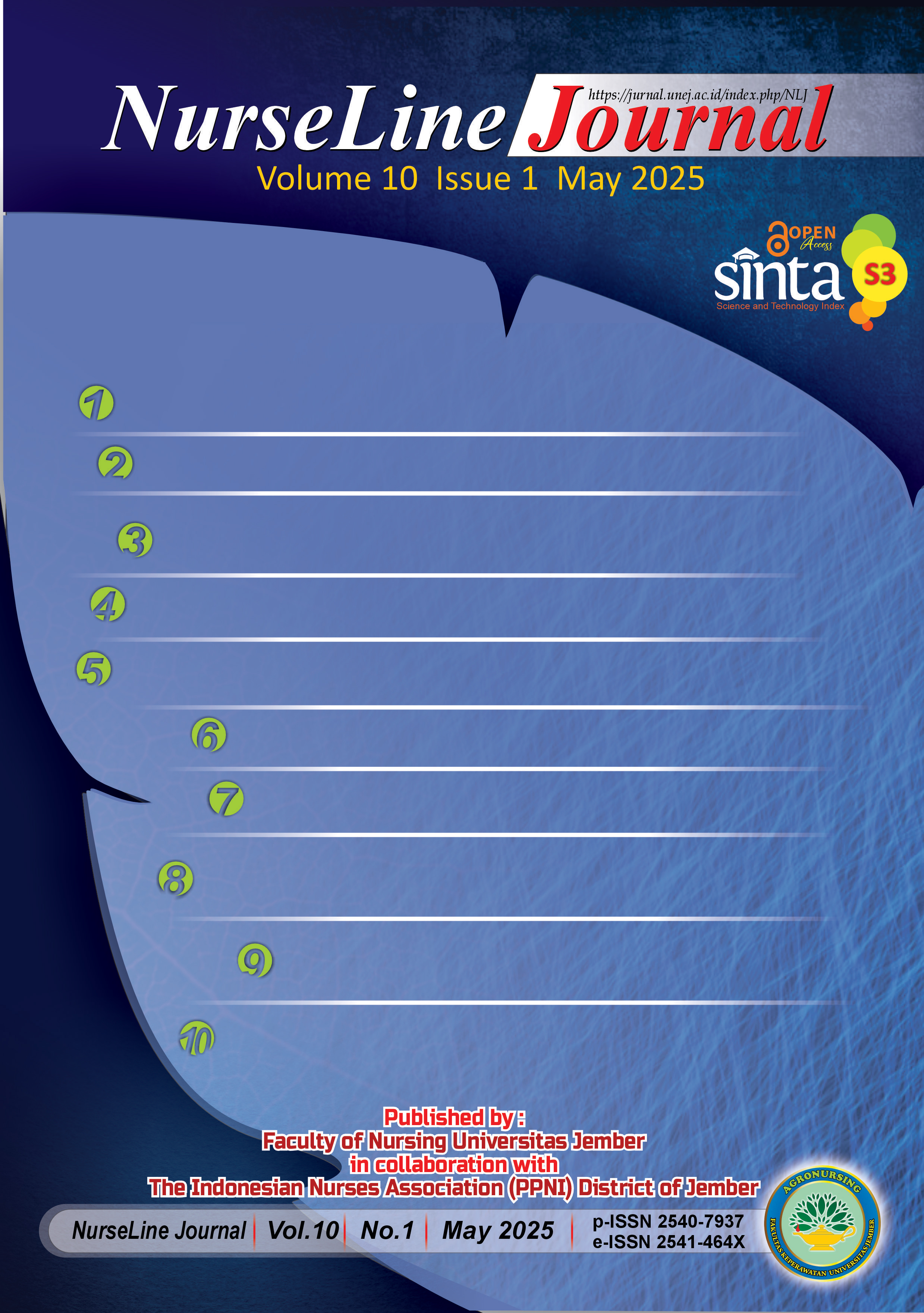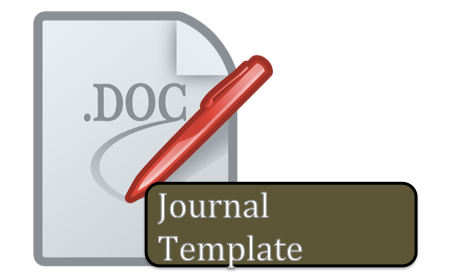Supporting Factors of Maternal-Fetal Attachment In Pregnant Women With Chronic Energy Deficiency In Yogyakarta, Indonesia
DOI:
https://doi.org/10.19184/nlj.v10i1.53688Keywords:
maternity, nurse, midwifery, bonding, nutrition, chronic deficiencyAbstract
Background: Most interventions to address Chronic Energy Deficiency (CED) have focused on physical aspects. Objective: Study aims to analyze maternal-fetal attachment (MFA) supporting factors in pregnant women with CED. Cross-sectional study design. 76 pregnant women in their 2nd and 3rd trimesters using purposive sampling. Methods: Sociodemographic factors were collected using sociodemographic questionnaires developed by researchers. Anxiety levels using PRAQ-R2, perceived social support using MSPSS, MFA using Indonesian version of IPAI. Data were analyzed using the Chi-square test and logistic regression to determine the most influential factors on MFA. Results: Maternal age emerged as a significant predictor of MFA (Wald p=0.018). Individual factors: anxiety, social support, education, income, parity, health history were not statistically significant (p>0.05), their combined effect was significant (Chi-square p=0.001; value=24.357; table value=14.067). Conclusion: To increase MFA levels is providing proper education regarding pregnancy readiness and age-appropriate conception. Maternal age plays key role in MFA among women with CED. Women in optimal reproductive age tend to develop stronger fetal attachment. These findings importance of promoting pregnancy preparedness and encouraging childbearing at ideal reproductive ages to enhance maternal-fetal attachment.
Downloads
References
Abdalla, M. et al. (2024) ‘Nutrition and diet myths, knowledge and practice during pregnancy and lactation among a sample of Egyptian pregnant women: a cross-sectional study’, BMC Pregnancy and Childbirth, 24(1), pp. 1–9. Available at: https://doi.org/10.1186/s12884-024-06331-3
Abdillah, S. (2022) ‘The effect of maternal and child factors on stunting in children under five years in rural Indonesia’, KnE Life Sciences [Preprint]. Available at: https://doi.org/10.18502/kls.v7i2.10382
Ahmad, M., Sechi, C. and Vismara, L. (2024) ‘Advanced Maternal Age: A Scoping Review about the Psychological Impact on Mothers, Infants, and Their Relationship’, Behavioral Sciences, 14(3). Available at: https://doi.org/10.3390/bs14030147.
Aitken, Z. et al. (2016) ‘Young maternal age at first birth and mental health later in life: Does the association vary by birth cohort?’, Social Science and Medicine, 157, pp. 9–17. Available at: https://doi.org/10.1016/j.socscimed.2016.03.037.
Akbarini, O.F. and Siswina, T. (2022) ‘Factors Affecting the Incidence of Chronic Energy Deficiency (CED) in Pregnant Women’, Science Midwifery, 10(5), pp. 3776–3783. Available at: https://doi.org/10.35335/midwifery.v10i5.841.
Al-Mutawtah, M. et al. (2023) ‘Women’s experiences of social support during pregnancy: a qualitative systematic review’, BMC Pregnancy and Childbirth, 23(1). Available at: https://doi.org/10.1186/s12884-023-06089-0
.
Anjarwati, A. and Suryaningsih, E.K. (2021) ‘The relationship between pregnancy-related anxiety and maternal-fetal attachment among primigravida’, Open Access Macedonian Journal of Medical Sciences, 9, pp. 47–51. Available at: https://doi.org/10.3889/oamjms.2021.6586.
Antonio, D. et al. (2020) ‘The pregnancy anxiety questionnaire revised-2’, European Journal of Psychological Assessment, 36(5), pp. 787–795.
Bowlby, J. (1969) Attachment: Attachment and Loss Volume One(Basic Books Classics). II. Ursula: Basic Books. Available at: http://www.amazon.com/Attachment-Volume-Basic-Books-Classics/dp/0465005438 .
Branjerdporn, G. et al. (2021) ‘Maternal–Fetal Attachment: Associations with Maternal Sensory Processing, Adult Attachment, Distress and Perinatal Loss’, Journal of Child and Family Studies, 30(2), pp. 528–541. Available at: https://doi.org/10.1007/s10826-020-01876-1.
Branjerdporn, G. et al. (2022) ‘Infant Developmental Outcomes : Influence of Prenatal Maternal – Fetal Attachment, Adult Attachment, Maternal’, International Journal of nvironmental Research and Public Health, 19(2433), pp. 1–13. Available at: https://doi.org/https://doi.org/10.3390/ijerph19042433.
Cavazos-Rehg, P.A. et al. (2015) ‘Maternal Age and Risk of Labor and Delivery Complications’, Maternal and Child Health Journal, 19(6), pp. 1202–1211. Available at: https://doi.org/10.1007/s10995-014-1624-7.
Chilot, D. et al. (2023) ‘Triple burden of malnutrition among mother-child pairs in low-income and middle-income countries: A cross-sectional study’, BMJ Open, 13(5), pp. 1–9. Available at: https://doi.org/10.1136/bmjopen-2022-070978.
Delavari, M., Mirghafourvand, M. and Mohammad-Alizadeh-Charandabi, S. (2018) ‘The relationship of maternal–fetal attachment and depression with social support in pregnant women referring to health centers of Tabriz–Iran, 2016’, Journal of Maternal-Fetal and Neonatal Medicine, 31(18), pp. 2450–2456. Available at: https://doi.org/10.1080/14767058.2017.1344961.
Dieny, F.F. et al. (2020) ‘Kualitas diet, kurang energi kronis (KEK), dan anemia pada pengantin wanita di Kabupaten Semarang’, Jurnal Gizi Indonesia, 8(1), p. 1. Available at: https://doi.org/10.14710/jgi.8.1.1-10.
Dinas Kesehatan Kabupaten Gunungkidul (2021) ‘LAPORAN KINERJA INSTANSI PEMERINTAH (LKj IP) DINAS KESEHATAN KABUPATEN GUNUNGKIDUL TAHUN 2021’, Dinas Kesehatan Gunungkidul, (0274), pp. 1–60.
E, S. (1960) ‘Slovin’s Formula for Sampling Technique’, Journal of Geoscience and Environment Protection, p. 8.
Fatmawati, F. et al. (2023) ‘Nutritional Addition To Increasing the Weight of Pregnant Women With Chronic Energy Deficiency in the Coastal Area of Kendari City’, Indonesian Journal of Health Sciences Research and Development (Ijhsrd), 5(2), pp. 115–121. Available at: https://doi.org/10.36566/ijhsrd/vol5.iss2/182.
Fitraniar, I. et al. (2022) ‘Determinan stunting pada bayi usia 0 – 24 bulan di Kabupaten Pidie: Studi kasus-kontrol’, AcTion: Aceh Nutrition Journal, 7(2), p. 187. Available at: https://doi.org/10.30867/action.v7i2.502.
Fitriah, I.P. et al. (2023) ‘Anemia Dengan Kejadian Kekurangan Energi Kronik (KEK) Pada Ibu Hamil’, Jik Jurnal Ilmu Kesehatan, 7(1), p. 124. Available at: https://doi.org/10.33757/jik.v7i1.704.
Fitriani, F., Yarmaliza, Y. and Farisni, T.N. (2024) ‘Analyzing the Level of Knowledge, Food Consumption Diversity, and Nutritional Intake on Chronic Energy Deficiency among Pregnant Women in Stunting Prevention’, European Journal of Medical and Health Sciences, 6(2), pp. 62–66. Available at: https://doi.org/10.24018/ejmed.2024.6.2.1939.
Hailemeskel, H.S. et al. (2022) ‘Mother-Infant Bonding and Its Associated Factors Among Mothers in the Postpartum Period, Northwest Ethiopia, 2021’, Frontiers in Psychiatry, 13(July), pp. 1–9. Available at: https://doi.org/10.3389/fpsyt.2022.893505.
Halli, S.S., Biradar, R.A. and Prasad, J.B. (2022) ‘Low Birth Weight, the Differentiating Risk Factor for Stunting among Preschool Children in India’, International Journal of Environmental Research and Public Health, 19(7). Available at: https://doi.org/10.3390/ijerph19073751.
Kamila, U., Zakiyyah, M. and Suhartin, S. (2024) ‘Hubungan Pendapatan Keluarga dengan Kejadian Kekurangan Energi Kronil pada Ibu Hamil Terimester 1 di Desa Pengarang Kecamatan Jambesari Darussholah’, TRILOGI: Jurnal Ilmu Teknologi, Kesehatan, dan Humaniora, 5(1), pp. 174–182. Available at: https://doi.org/10.33650/trilogi.v5i1.8296
Kato, T. et al. (2017) ‘Association of maternal age with child health: A Japanese longitudinal study’, PLoS ONE, 12(2), pp. 1–11. Available at: https://doi.org/10.1371/journal.pone.0172544.
Kemenkes RI (2022a) ‘Hasil Survei Status Gizi Indonesia (SSGI) 2022’, Kemenkes, pp. 1–150.
Kemenkes RI (2022b) ‘laporan akuntabilitas kinerja instansi pemerintah (LAKIP)’, Journal of Chemical Information and Modeling, 53(9), pp. 1689–1699.
Khairani, F. and Ningsih, H. (2024) ‘Hubungan Kurang Energi Kronik (KEK) Dengan Kejadian Stunting Pada Balita 2-4 Tahun Di Wilayah Kerja UPTD Puskesmas Pringgarata’, Jurnal Cahaya Mandalika, 5(1), pp. 704–712. Available at: https://doi.org/10.36312/jcm.v5i2.3126
Kuntari, T. et al. (2024) ‘Chronic energy deficiency in young pregnant women in rural Indonesia: an analysis of basic health survey 2018’, Jurnal Ners, 19(4), pp. 433–440. Available at: https://doi.org/10.20473/jn.v19i4.56196.
Lipoeto, N.I., Masrul and Nindrea, R.D. (2020) ‘Nutritional contributors to maternal anemia in Indonesia: Chronic energy deficiency and micronutrients’, Asia Pacific Journal of Clinical Nutrition, 29(December), pp. 9–17. Available at: https://doi.org/10.6133/APJCN.202012_29(S1).02
Mahmoud, T.M. et al. (2019) ‘Anxiety and Fear Level toward Childbirth among Primigravida versus Multigravida’, 8(2), pp. 36–44. Available at: https://doi.org/10.9790/1959-0802023644.
Maurizatilla, Putra, M. and Khalidah (2024) ‘Faktor-Faktor yang Berhubungan dengan Kekurangan Energi kronik (KEK) pada Ibu Hamil di UPTD Puskesmas Tanah Luas Kabupaten Aceh Utara’, 5(1), pp. 1–15. Available at: https://jim.bbg.ac.id/kesehatan/article/download/2077/698/5483
Moniri, M. et al. (2023) ‘The relationship between pregnancy and birth experience with maternal-fetal attachment and mother-child bonding: a descriptive-analytical study’, BMC Psychology, 11(1), pp. 1–9. Available at: https://doi.org/10.1186/s40359-023-01475-x.
Mustafa, H. et al. (2021) ‘Faktor Risiko Dominan Mempengaruhi Kurang Energi Kronis (KEK) pada Ibu Hamil di Indonesia Tahun 2018’, Buletin Penelitian Kesehatan, 49(2), pp. 105–112. Available at: https://doi.org/10.22435/bpk.v49i2.4773
Nasaru, J. et al. (2024) ‘Factors Associated with Chronic Energy Deficiency (CED) in Pregnant Women: A Study in North Gorontalo Regency, 2023’, BIO Web of Conferences, 133, pp. 1–17. Available at: https://doi.org/10.1051/bioconf/202413300003.
Rahma, I.M. and Mutalazimah, M. (2022) ‘Correlation between Family Income and Stunting among Toddlers in Indonesia: A Critical Review’, Proceedings of the International Conference on Health and Well-Being (ICHWB 2021), 49(Ichwb 2021), pp. 78–86. Available at: https://doi.org/10.2991/ahsr.k.220403.011.
Retnaningrum, D.N. and Rahmawati, W. (2022) ‘PENCEGAHAN KEHAMILAN KEKURANGAN ENERGI KRONIK DENGAN PEMBERDAYAAN KADER PKB (PRODUK KUE BAYAM)’, 2(1), pp. 100–104. Available at: https://mhjcs.widyagamahusada.ac.id/index.php/jbo/article/download/27/23/254
Rifki, M.A. et al. (2022) ‘Perbedaan asupan energi dan zat gizi makro berdasarkan kejadian risiko KEK pada ibu hamil’, Jurnal Gizi Klinik Indonesia, 18(4), p. 181. Available at: https://doi.org/10.22146/ijcn.33732.
Rosyidah, M., Dewi, Y.L.R. and Qadrijati, I. (2021) ‘Effects of Stunting on Child Development: A Meta-Analysis’, Journal of Maternal and Child Health, 6(1), pp. 25–34. Available at: https://doi.org/10.26911/thejmch.2021.06.01.03.
Sanou, A.S. et al. (2018) ‘Association between stunting and neuro-psychological outcomes among children in Burkina Faso, West Africa’, Child and Adolescent Psychiatry and Mental Health, 12(1), pp. 1–10. Available at: https://doi.org/10.1186/s13034-018-0236-1
Sharma, D., Shastri, S. and Sharma, P. (2016) ‘Intrauterine Growth Restriction: Antenatal and Postnatal Aspects’, Clinical Medicine Insights: Pediatrics, 10, p. CMPed.S40070. Available at: https://doi.org/10.4137/cmped.s40070.
Soliman, A. et al. (2021) ‘Early and long-term consequences of nutritional stunting: from childhood to adulthood’, Acta Bio Medica … [Preprint]. ncbi.nlm.nih.gov. Available at: https://doi.org/10.23750/abm.v92i1.11346
Sukriani, W., Suryaningsih, E.K. and Linh, N.D. (2020) ‘The relationship of the maternal-fetal attachment and the attitude toward exclusive breastfeeding among pregnant women in Indonesia’, Journal of Health Technology Assessment in Midwifery, 3(1), pp. 18–23. Available at: https://doi.org/10.31101/jhtam.1324.
Suryaningsih, E.. et al. (2021) ‘Translation and Validation of the Indonesia Version of Prenatal Attachment Inventory : A Preliminary Study’, International Journal of Caring Science, 14(1), pp. 543–549.
Suryaningsih, E.K. (2016) ‘The Association of Maternal-Fetal Attachment and Mother’s Education Level Among Pregnant Women In Indonesia’, International Conference on Health Science and Technology (ICHST), (63), pp. 435–439.
Suryaningsih, E.K., Gau, M.L. and Wantonoro (2020) ‘Concept analysis of maternal-fetal attachment’, Belitung Nursing Journal, 6(5), pp. 157–164. Available at: https://doi.org/10.33546/bnj.1194
Susiloretni, K.A. et al. (2021) ‘The psychological distress of parents is associated with reduced linear growth of children: Evidence from a nationwide population survey’, PLoS ONE, 16(10 October), pp. 1–23. Available at: https://doi.org/10.1371/journal.pone.0246725.
Svensson, K. et al. (2023) ‘Maternal nutrition during mid-pregnancy and children’s body composition at 7 years of age in the SELMA study’, British Journal of Nutrition, 130(11), pp. 1982–1992. Available at: https://doi.org/10.1017/S0007114523000983.
Teweldemedhin, L.G. et al. (2021) ‘Effect of nutrition education by health professionals on pregnancy-specific nutrition knowledge and healthy dietary practice among pregnant women in Asmara, Eritrea: A quasi-experimental study’, BMJ Nutrition, Prevention and Health, 4(1), pp. 181–194. Available at: https://doi.org/10.1136/bmjnph-2020-000159
Triyawati, L. and Yuliani, E. (2023) ‘Knowledge, education, and information affect chronic energy deficiency among pregnant mothers in the area of Public Health Center Balen, Bojonegoro, Indonesia’, Majalah Obstetri & Ginekologi, 31(1), pp. 1–10. Available at: https://doi.org/10.20473/mog.v31i12023.1-10.
Vaivada, T. et al. (2020) ‘Stunting in childhood: An overview of global burden, trends, determinants, and drivers of decline’, American Journal of Clinical Nutrition, 112, pp. 777S-791S. Available at: https://doi.org/10.1093/ajcn/nqaa159.
Victora, C.G. et al. (2021) ‘Revisiting maternal and child undernutrition in low-income and middle-income countries: variable progress towards an unfinished agenda’, The Lancet [Preprint]. Available at: https://doi.org/10.1016/s0140-6736(21)00394-9
Vilcins, D., Sly, P.D. and Jagals, P. (2018) ‘Environmental risk factors associated with child stunting: a systematic review of the literature’, Annals of global health [Preprint]. ncbi.nlm.nih.gov. Available at: https://doi.org/10.9204/aogh.2361
Waclawek, T. and Park, S.Q. (2023) ‘Potential mechanisms and modulators of food intake during pregnancy’, Frontiers in Nutrition, 10(January), pp. 1–10. Available at: https://doi.org/10.3389/fnut.2023.1032430.
Wati, E.K. et al. (2024) ‘Determinants of chronic energy deficiency (CED) incidence in pregnant women: A cross-sectional study in Banyumas, Indonesia’, pp. 1–8.
World Health Organization (2023) Child malnutrition: Stunting among children under 5 years of age.Available at: https://www.who.int/data/gho/indicator-metadata-registry/imr-details/72
Wubie, A. et al. (2020) ‘Determinants of chronic energy deficiency among non-pregnant and non-lactating women of reproductive age in rural Kebeles of Dera District, North West Ethiopia, 2019: Unmatched case control study’, PLoS ONE, 15(10 October), pp. 1–12. Available at: https://doi.org/10.1371/journal.pone.0241341.
Yoon, H. and Choi, H. (2023) ‘Factors influencing maternal-fetal attachment in pregnant women during the COVID-19 pandemic: a cross-sectional study’, Korean Journal of Women Health Nursing, 29(1), pp. 55–65. Available at: https://doi.org/10.4069/kjwhn.2023.02.21.3
Yuningsih, Y. and Perbawati, D. (2022) ‘Hubungan Jenis Kelamin terhadap Kejadian Stunting’, Jurnal MID-Z (Midwivery Zigot) Jurnal Ilmiah Kebidanan, 5(1), pp. 48–53. Available at: https://doi.org/10.56013/jurnalmidz.v5i1.1365.
Zimet, G. et al. (1988) ‘Multidimensional Scale of Perceived Social Support (MSPSS)’, J Pers Assess, 52(December), pp. 30–41. Available at: http://gzimet.wix.com/mspss.
Downloads
Published
Issue
Section
License
Copyright (c) 2025 NurseLine Journal

This work is licensed under a Creative Commons Attribution-ShareAlike 4.0 International License.








